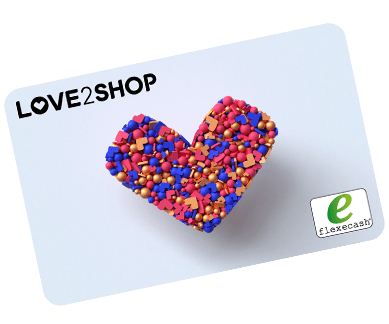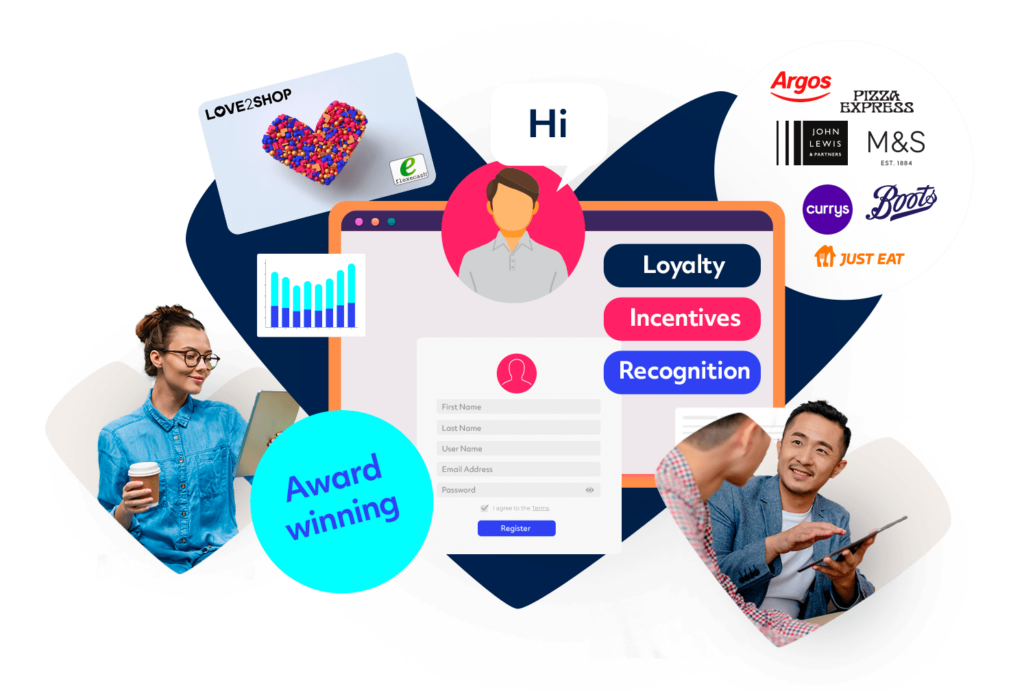An introduction to employee engagement
Here at business.highstreetvouchers.com we’ll look at how engaging employees is good for them and good for business. We’ll reveal best practices for engagement in the workplace and explain how to engage employees in your business.
So what is employee engagement? The term ‘employee engagement’ is believed to have first appeared in 1990 as a concept introduced by William A Kahn in his paper on ‘Psychological Conditions of Personal Engagement and Disengagement at Work.’
Ironically, this is not the most ‘engaging’ article. The ideas it explored however have been developed over more than 30 years into effective, evidence-based workplace practices. These methods are proven to help build stronger relationships between employers, employees and their job roles. Engaged employees are proven to drive business performance through positive actions.
According to our recent Employee Value Report, 56% of prospects consider an employer’s rewards, culture, incentives and employee happiness ratings before applying for a job. Meanwhile research carried out in 2022 by project management experts Teamstage showed 70% of employees would be more productive with effective communication in place.
We asked our expert team to explain how to engage employees. We’ve used that knowledge to help you get started on your engagement journey.
The Three Cs
Let’s start with the basics – Compensation, Career Path and Culture.
Known as the Three C’s, these are the building blocks of employee engagement.
First up is the most obvious one – Compensation. How much you pay people obviously has a direct effect on how engaged they are. Set pay too low and employees struggle to remain motivated and will look to move on quickly. The result is a painful loop of training up new staff then struggling to retain them. You need to find the right balance between the market value of each role, the skill level of your employees and how fulfilling they find their role.
The second C is Career Path. Even the happiest, most fulfilled employees want their efforts to be recognised and rewarded. Having a career path allows them to set goals for improvement and enjoy the satisfaction of achieving those and earning greater rewards.
Creating a clear career path for employees has a huge effect on motivation and engagement. When people understand very clearly what they need to achieve to reach the next stage of their career, they are more motivated to do it.
The final C is Culture. This is where employee engagement strategies can have a real impact. How do your employees feel about their work? Do they feel respected, treated fairly and are do you offer any benefits or perks that make their life better or easier?
Depending on the size of your business, compensation and career path can take time to change. Culture however can be the catalyst for change. With the right strategy in place, you can start implementing cultural change fairly quickly in the workplace and, if you remain consistent in your approach, start seeing the benefits within a short space of time.
How can we create an effective employee engagement strategy?
Deciding on a series of employee engagement measures is easy, ensuring they are effective, meaningful and deliver positive cultural change is the challenge.
Crucially, creating an employee engagement strategy must be a collaborative process. Consult with your workforce, through focus groups or surveys, to find out what matters to them.
Introducing employee engagement measures they people don’t want, can’t access and bring them no real benefit will at best be ignored and at worse will prove costly and further disengage the very people you’re trying to strengthen our connection with.
Focus on the core elements of engagement – do your employees feel communication can be improved? Do they feel that their effort and loyalty are rewarded or even recognised by the business? Do the recognition and incentives offered by your business make them feel valued?
Your goal is to understand what motivates them and what matters to them. Often they spend a significant amount of their time working in your business, you need to understand whether they feel invested in the business and how to create a workplace environment that helps them feel encouraged to give you their best.
Establishing how they feel about your existing reward, recognition and engagement policies and asking them to suggest their own alternatives is a solid foundation to build a new employee engagement strategy on.
Don’t confuse happiness with engagement
Setting yourself a goal to make everyone happy is not an employee engagement strategy. The same applies to hyper-focusing on employee wellbeing or satisfaction.
All of these things will likely play a part in your engagement strategy, but you need to be led by employee feedback and the needs of the business. The goal of your strategy needs to be to create a working environment where employees feel able to realise their full potential, motivated to employ their full range of skills to helping the company achieve its goals and proud when they help to successfully deliver on them.
An engagement strategy may include wellbeing measures like mindfulness sessions or workplace socials, and your desired outcomes may include happier, more satisfied employees.
But happy, satisfied employees are not automatically engaged employees. They may be happy to coast through rather than be proactive and productive. To build engagement and the benefits it brings you need a to build a deep, strong connection to your company specifically across your entire team rather than focusing on individual outcomes.
Most importantly, whatever your employee engagement strategy looks like in practice, it must be genuine and authentic.
A strategy that is designed around the idea of extracting more effort from your workforce will be found out very quickly. The result will be the opposite, as employees disengage and lose trust in your business. Avoid trade-offs or offering rewards in return for effort. If they are appropriate, those benefits should be built into employee contracts as an incentive, not included in your employee engagement plans.
Your employee engagement strategy needs to be built on a real objective to create a positive culture of reward and recognition within your business. Your goal is to create a place where people want to work and feel their efforts are valued.
Focus on that, and the benefits will follow.
Engage smarter, not harder
Knowledge is power, so understanding a little employee engagement best practice will help you to deliver your strategy.
For example, if you’re looking to improve communication and peer-to-peer recognition, you may look at a modular engagement platform. This makes it easy, even when people are working remotely, to give colleagues praise for great work and support using a dedicated digital engagement space.
Such systems can often also be used to consult employees more regularly for feedback to ensure that your engagement strategy remains relevant and up-to-date. The data they produce can offer an incredible snapshot of your business culture.
If a platform is not the right solution for you, small, spontaneous rewards can be a great way to keep staff motivated and engaged. But did you know in the UK they can also be given out tax-free?
HMRC’s Trivial Benefits rules allow businesses to give individual employees non-cash gifts up to the value of £50 tax-free – so long as it’s not a contracted bonus or a reward for their work. This includes gift cards like Love2shop. Businesses can buy them at business.highstreetvouchers.com so they are on hand to instantly reward people for being great colleagues.
Another way to reinforce your employee engagement strategy and positive cultural change can be to hold social functions.
Again, there is a tax and National Insurance exemption for these events, so long as they are annual, open to all employees and cost £150 per person or less. This also applies to virtual parties, where remote workers may dial in via conferencing software and be provided with a gift voucher to pay for food and drink.
Understanding how to create efficient, effective engagement processes that employees will use and value is vital to ensuring your strategy is successful.
Start building a more motivated workforce
Whether your organisation is large or small, the first step is always the same – get started!
Conversations between management and HR teams can get the ball rolling but the most important thing is to start having them.
Once you’ve decided how best to consult your employees and begun the process, you can follow the process to its natural conclusion and use the feedback you have gathered to create your first strategy.
Boost employee engagement with Love2shop
In today’s competitive job market, it’s more important than ever to keep your employees engaged and motivated. Love2shop can help you do just that.
Love2shop is a leading provider of employee engagement solutions. We offer a variety of products and services that can help you reward your employees, recognize their achievements, and boost their morale.
Our most popular employee engagement product is the Love2shop Engagement Platform. This online platform allows you to easily create and manage employee rewards and recognition programs. You can choose from a variety of rewards, including Love2shop gift cards, which can be spent at over 90 popular retailers.
The Love2shop Engagement Platform also makes it easy to recognize your employees for their hard work and dedication. You can send them e-cards, give them badges, and leave them comments. All of this recognition is displayed on the platform, so your employees can see how much you appreciate them.
Love2shop solutions are used by businesses of all sizes, from small businesses to Fortune 500 companies. We have a proven track record of helping businesses improve employee engagement and morale. Contact us now to see how we can help you today.
Love2shop Gift Cards
Love2shop Gift Cards are accepted in 90+ brands across the UK.
They are the perfect thank you gift for employees or customers.
For orders over £10,000
For orders under £10,000

Online and in-store digital Mastercard
Love2shop Contactless makes the process of managing rewards and recognition easy, instant and digital.
Secure bulk ordering to reward your employees and customers.
For orders over £10,000
For orders under £10,000

Love2shop e-Gift Cards
Sent and redeemed online, a Love2shop e-Gift Card lets a customer or employee pick their reward from a selection of popular shopping, dining, and experience brands.
For orders over £10,000
For orders under £10,000

Love2shop Gift Vouchers
Always popular, Love2shop Gift Vouchers are ideal for employee rewards, staff incentives, corporate gifts, sales promotions, research incentives, and referral schemes.
For orders over £10,000
For orders under £10,000

Love2shop Holidays Gift Cards
Love2shop Holidays Gift Cards can be used as full or part-payment towards holidays around the world, or at home in the UK.
Nothing inspires quite like travel, and a Love2shop Holidays Gift Card puts that power in your hands.
For orders over £10,000
For orders under £10,000

Love2shop Engagement Platform



